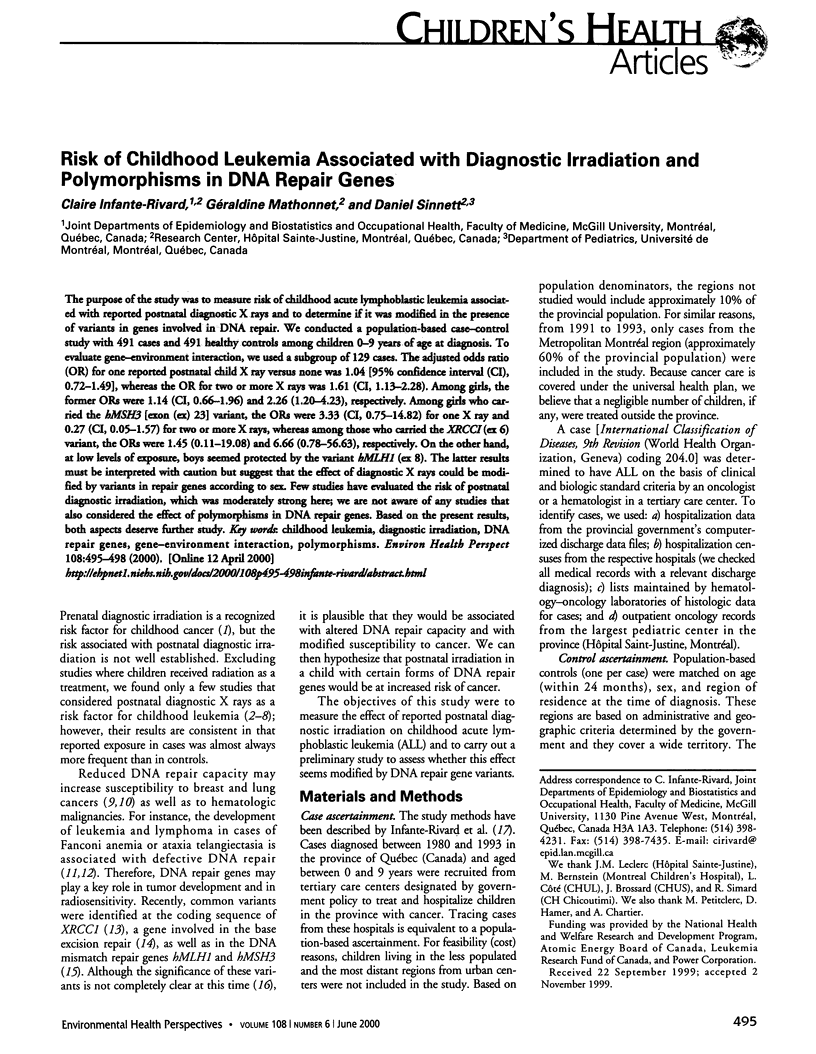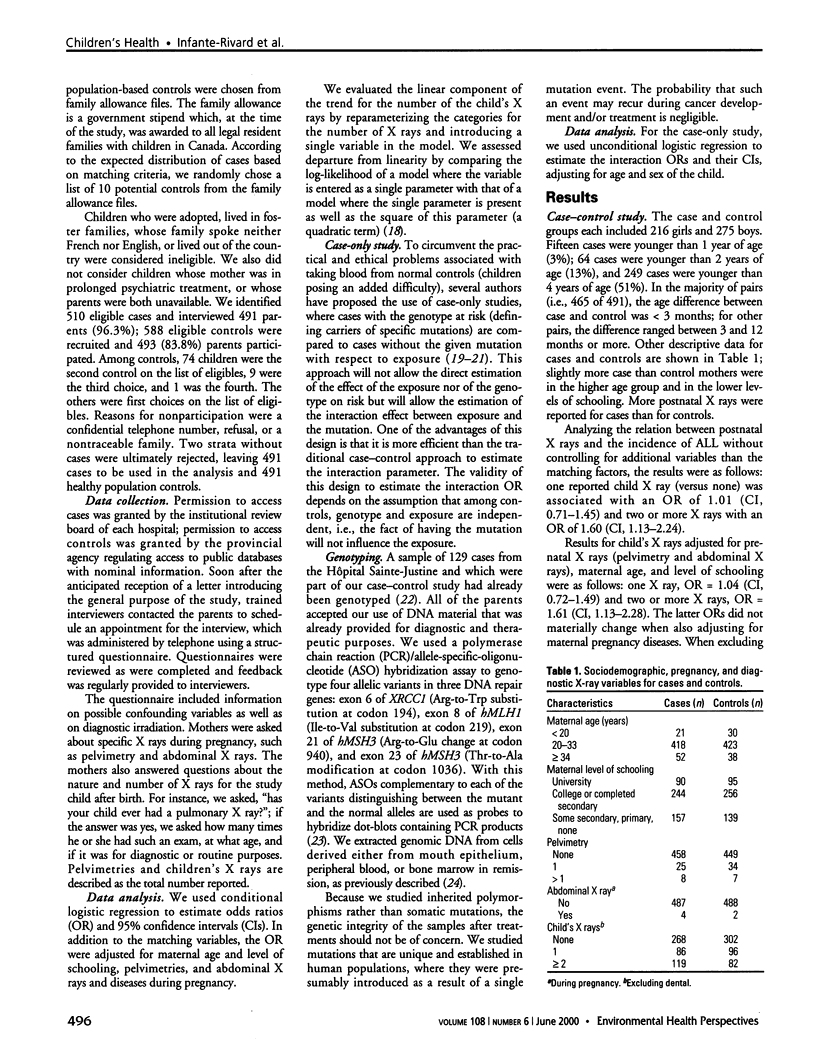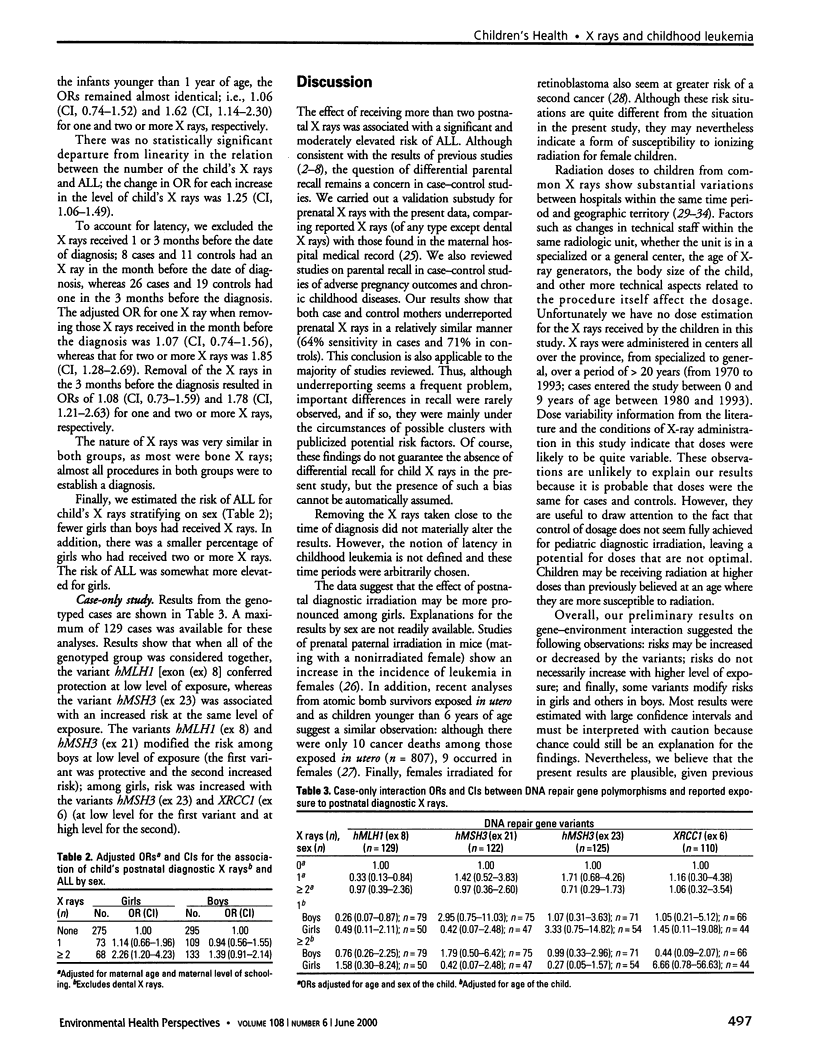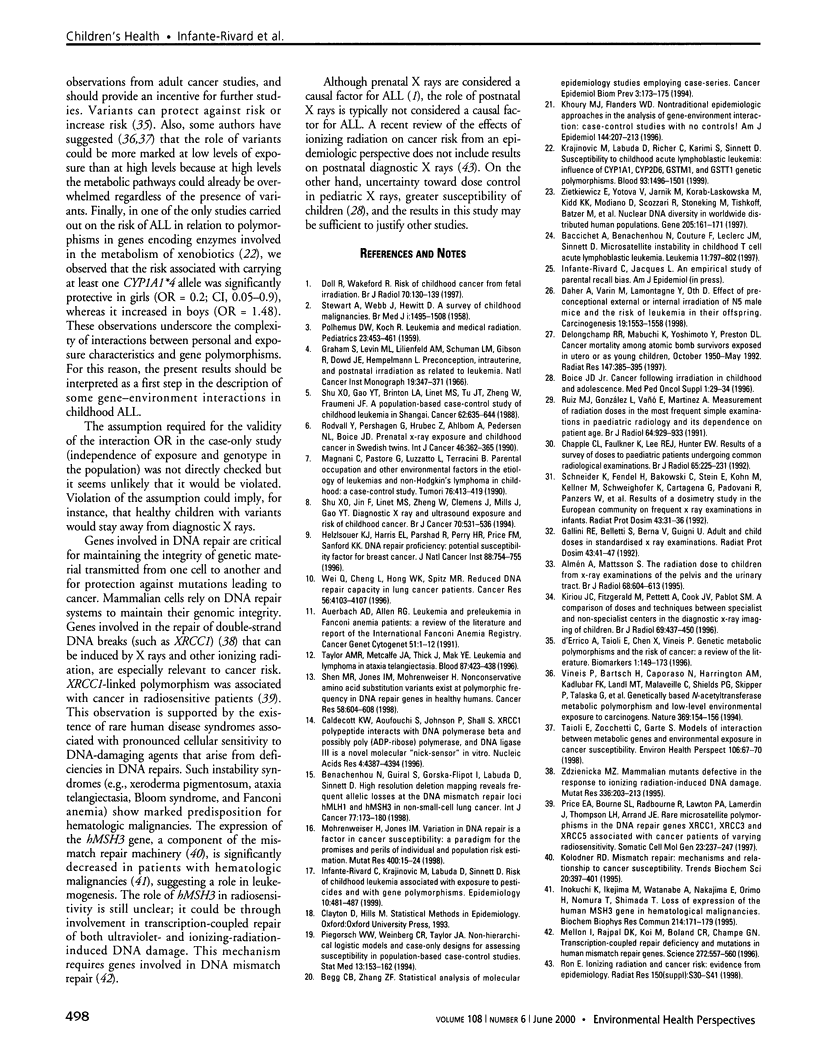Abstract
The purpose of the study was to measure risk of childhood acute lymphoblastic leukemia associated with reported postnatal diagnostic X rays and to determine if it was modified in the presence of variants in genes involved in DNA repair. We conducted a population-based case-control study with 491 cases and 491 healthy controls among children 0-9 years of age at diagnosis. To evaluate gene-environment interaction, we used a subgroup of 129 cases. The adjusted odds ratio (OR) for one reported postnatal child X ray versus none was 1.04 [95% confidence interval (CI), 0.72-1.49], whereas the OR for two or more X rays was 1.61 (CI, 1.13-2.28). Among girls, the former ORs were 1.14 (CI, 0.66-1.96) and 2.26 (1. 20-4.23), respectively. Among girls who carried the hMSH3 [exon (ex) 23] variant, the ORs were 3.33 (CI, 0.75-14.82) for one X ray and 0. 27 (CI, 0.05-1.57) for two or more X rays, whereas among those who carried the XRCCI (ex 6) variant, the ORs were 1.45 (0.11-19.08) and 6.66 (0.78-56.63), respectively. On the other hand, at low levels of exposure, boys seemed protected by the variant hMLH1 (ex 8). The latter results must be interpreted with caution but suggest that the effect of diagnostic X rays could be modified by variants in repair genes according to sex. Few studies have evaluated the risk of postnatal diagnostic irradiation, which was moderately strong here; we are not aware of any studies that also considered the effect of polymorphisms in DNA repair genes. Based on the present results, both aspects deserve further study.
Full text
PDF



Selected References
These references are in PubMed. This may not be the complete list of references from this article.
- Almén A., Mattsson S. The radiation dose to children from X-ray examinations of the pelvis and the urinary tract. Br J Radiol. 1995 Jun;68(810):604–613. doi: 10.1259/0007-1285-68-810-604. [DOI] [PubMed] [Google Scholar]
- Auerbach A. D., Allen R. G. Leukemia and preleukemia in Fanconi anemia patients. A review of the literature and report of the International Fanconi Anemia Registry. Cancer Genet Cytogenet. 1991 Jan;51(1):1–12. doi: 10.1016/0165-4608(91)90002-c. [DOI] [PubMed] [Google Scholar]
- Baccichet A., Benachenhou N., Couture F., Leclerc J. M., Sinnett D. Microsatellite instability in childhood T cell acute lymphoblastic leukemia. Leukemia. 1997 Jun;11(6):797–802. doi: 10.1038/sj.leu.2400650. [DOI] [PubMed] [Google Scholar]
- Begg C. B., Zhang Z. F. Statistical analysis of molecular epidemiology studies employing case-series. Cancer Epidemiol Biomarkers Prev. 1994 Mar;3(2):173–175. [PubMed] [Google Scholar]
- Benachenhou N., Guiral S., Gorska-Flipot I., Labuda D., Sinnett D. High resolution deletion mapping reveals frequent allelic losses at the DNA mismatch repair loci hMLH1 and hMSH3 in non-small cell lung cancer. Int J Cancer. 1998 Jul 17;77(2):173–180. doi: 10.1002/(sici)1097-0215(19980717)77:2<173::aid-ijc1>3.0.co;2-n. [DOI] [PubMed] [Google Scholar]
- Boice J. D., Jr Cancer following irradiation in childhood and adolescence. Med Pediatr Oncol Suppl. 1996;1:29–34. [PubMed] [Google Scholar]
- Caldecott K. W., Aoufouchi S., Johnson P., Shall S. XRCC1 polypeptide interacts with DNA polymerase beta and possibly poly (ADP-ribose) polymerase, and DNA ligase III is a novel molecular 'nick-sensor' in vitro. Nucleic Acids Res. 1996 Nov 15;24(22):4387–4394. doi: 10.1093/nar/24.22.4387. [DOI] [PMC free article] [PubMed] [Google Scholar]
- Chapple C. L., Faulkner K., Lee R. E., Hunter E. W. Results of a survey of doses to paediatric patients undergoing common radiological examinations. Br J Radiol. 1992 Mar;65(771):225–231. doi: 10.1259/0007-1285-65-771-225. [DOI] [PubMed] [Google Scholar]
- Daher A., Varin M., Lamontagne Y., Oth D. Effect of pre-conceptional external or internal irradiation of N5 male mice and the risk of leukemia in their offspring. Carcinogenesis. 1998 Sep;19(9):1553–1558. doi: 10.1093/carcin/19.9.1553. [DOI] [PubMed] [Google Scholar]
- Delongchamp R. R., Mabuchi K., Yoshimoto Y., Preston D. L. Cancer mortality among atomic bomb survivors exposed in utero or as young children, October 1950-May 1992. Radiat Res. 1997 Mar;147(3):385–395. [PubMed] [Google Scholar]
- Doll R., Wakeford R. Risk of childhood cancer from fetal irradiation. Br J Radiol. 1997 Feb;70:130–139. doi: 10.1259/bjr.70.830.9135438. [DOI] [PubMed] [Google Scholar]
- Graham S., Levin M. L., Lilienfeld A. M., Schuman L. M., Gibson R., Dowd J. E., Hempelmann L. Preconception, intrauterine, and postnatal irradiation as related to leukemia. Natl Cancer Inst Monogr. 1966 Jan;19:347–371. [PubMed] [Google Scholar]
- Helzlsouer K. J., Harris E. L., Parshad R., Perry H. R., Price F. M., Sanford K. K. DNA repair proficiency: potential susceptiblity factor for breast cancer. J Natl Cancer Inst. 1996 Jun 5;88(11):754–755. doi: 10.1093/jnci/88.11.754. [DOI] [PubMed] [Google Scholar]
- Infante-Rivard C., Labuda D., Krajinovic M., Sinnett D. Risk of childhood leukemia associated with exposure to pesticides and with gene polymorphisms. Epidemiology. 1999 Sep;10(5):481–487. [PubMed] [Google Scholar]
- Inokuchi K., Ikejima M., Watanabe A., Nakajima E., Orimo H., Nomura T., Shimada T. Loss of expression of the human MSH3 gene in hematological malignancies. Biochem Biophys Res Commun. 1995 Sep 5;214(1):171–179. doi: 10.1006/bbrc.1995.2271. [DOI] [PubMed] [Google Scholar]
- Khoury M. J., Flanders W. D. Nontraditional epidemiologic approaches in the analysis of gene-environment interaction: case-control studies with no controls! Am J Epidemiol. 1996 Aug 1;144(3):207–213. doi: 10.1093/oxfordjournals.aje.a008915. [DOI] [PubMed] [Google Scholar]
- Kolodner R. D. Mismatch repair: mechanisms and relationship to cancer susceptibility. Trends Biochem Sci. 1995 Oct;20(10):397–401. doi: 10.1016/s0968-0004(00)89087-8. [DOI] [PubMed] [Google Scholar]
- Krajinovic M., Labuda D., Richer C., Karimi S., Sinnett D. Susceptibility to childhood acute lymphoblastic leukemia: influence of CYP1A1, CYP2D6, GSTM1, and GSTT1 genetic polymorphisms. Blood. 1999 Mar 1;93(5):1496–1501. [PubMed] [Google Scholar]
- Kyriou J. C., Fitzgerald M., Pettett A., Cook J. V., Pablot S. M. A comparison of doses and techniques between specialist and non-specialist centres in the diagnostic X-ray imaging of children. Br J Radiol. 1996 May;69(821):437–450. doi: 10.1259/0007-1285-69-821-437. [DOI] [PubMed] [Google Scholar]
- Magnani C., Pastore G., Luzzatto L., Terracini B. Parental occupation and other environmental factors in the etiology of leukemias and non-Hodgkin's lymphomas in childhood: a case-control study. Tumori. 1990 Oct 31;76(5):413–419. doi: 10.1177/030089169007600501. [DOI] [PubMed] [Google Scholar]
- Mellon I., Rajpal D. K., Koi M., Boland C. R., Champe G. N. Transcription-coupled repair deficiency and mutations in human mismatch repair genes. Science. 1996 Apr 26;272(5261):557–560. doi: 10.1126/science.272.5261.557. [DOI] [PubMed] [Google Scholar]
- Mohrenweiser H. W., Jones I. M. Variation in DNA repair is a factor in cancer susceptibility: a paradigm for the promises and perils of individual and population risk estimation? Mutat Res. 1998 May 25;400(1-2):15–24. doi: 10.1016/s0027-5107(98)00059-1. [DOI] [PubMed] [Google Scholar]
- POLHEMUS D. W., KOCH R. Leukemia and medical radiation. Pediatrics. 1959 Mar;23(3):453–461. [PubMed] [Google Scholar]
- Piegorsch W. W., Weinberg C. R., Taylor J. A. Non-hierarchical logistic models and case-only designs for assessing susceptibility in population-based case-control studies. Stat Med. 1994 Jan 30;13(2):153–162. doi: 10.1002/sim.4780130206. [DOI] [PubMed] [Google Scholar]
- Price E. A., Bourne S. L., Radbourne R., Lawton P. A., Lamerdin J., Thompson L. H., Arrand J. E. Rare microsatellite polymorphisms in the DNA repair genes XRCC1, XRCC3 and XRCC5 associated with cancer in patients of varying radiosensitivity. Somat Cell Mol Genet. 1997 Jul;23(4):237–247. doi: 10.1007/BF02674415. [DOI] [PubMed] [Google Scholar]
- Rodvall Y., Pershagen G., Hrubec Z., Ahlbom A., Pedersen N. L., Boice J. D. Prenatal X-ray exposure and childhood cancer in Swedish twins. Int J Cancer. 1990 Sep 15;46(3):362–365. doi: 10.1002/ijc.2910460304. [DOI] [PubMed] [Google Scholar]
- Ruiz M. J., González L., Vañ E., Martínez A. Measurement of radiation doses in the most frequent simple examinations in paediatric radiology and its dependence on patient age. Br J Radiol. 1991 Oct;64(766):929–933. doi: 10.1259/0007-1285-64-766-929. [DOI] [PubMed] [Google Scholar]
- STEWART A., WEBB J., HEWITT D. A survey of childhood malignancies. Br Med J. 1958 Jun 28;1(5086):1495–1508. doi: 10.1136/bmj.1.5086.1495. [DOI] [PMC free article] [PubMed] [Google Scholar]
- Shen M. R., Jones I. M., Mohrenweiser H. Nonconservative amino acid substitution variants exist at polymorphic frequency in DNA repair genes in healthy humans. Cancer Res. 1998 Feb 15;58(4):604–608. [PubMed] [Google Scholar]
- Shu X. O., Gao Y. T., Brinton L. A., Linet M. S., Tu J. T., Zheng W., Fraumeni J. F., Jr A population-based case-control study of childhood leukemia in Shanghai. Cancer. 1988 Aug 1;62(3):635–644. doi: 10.1002/1097-0142(19880801)62:3<635::aid-cncr2820620332>3.0.co;2-3. [DOI] [PubMed] [Google Scholar]
- Shu X. O., Jin F., Linet M. S., Zheng W., Clemens J., Mills J., Gao Y. T. Diagnostic X-ray and ultrasound exposure and risk of childhood cancer. Br J Cancer. 1994 Sep;70(3):531–536. doi: 10.1038/bjc.1994.340. [DOI] [PMC free article] [PubMed] [Google Scholar]
- Taioli E., Zocchetti C., Garte S. Models of interaction between metabolic genes and environmental exposure in cancer susceptibility. Environ Health Perspect. 1998 Feb;106(2):67–70. doi: 10.1289/ehp.9810667. [DOI] [PMC free article] [PubMed] [Google Scholar]
- Taylor A. M., Metcalfe J. A., Thick J., Mak Y. F. Leukemia and lymphoma in ataxia telangiectasia. Blood. 1996 Jan 15;87(2):423–438. [PubMed] [Google Scholar]
- Vineis P., Bartsch H., Caporaso N., Harrington A. M., Kadlubar F. F., Landi M. T., Malaveille C., Shields P. G., Skipper P., Talaska G. Genetically based N-acetyltransferase metabolic polymorphism and low-level environmental exposure to carcinogens. Nature. 1994 May 12;369(6476):154–156. doi: 10.1038/369154a0. [DOI] [PubMed] [Google Scholar]
- Wei Q., Cheng L., Hong W. K., Spitz M. R. Reduced DNA repair capacity in lung cancer patients. Cancer Res. 1996 Sep 15;56(18):4103–4107. [PubMed] [Google Scholar]
- Zdzienicka M. Z. Mammalian mutants defective in the response to ionizing radiation-induced DNA damage. Mutat Res. 1995 May;336(3):203–213. doi: 10.1016/0921-8777(95)00003-3. [DOI] [PubMed] [Google Scholar]
- Zietkiewicz E., Yotova V., Jarnik M., Korab-Laskowska M., Kidd K. K., Modiano D., Scozzari R., Stoneking M., Tishkoff S., Batzer M. Nuclear DNA diversity in worldwide distributed human populations. Gene. 1997 Dec 31;205(1-2):161–171. doi: 10.1016/s0378-1119(97)00408-3. [DOI] [PubMed] [Google Scholar]


